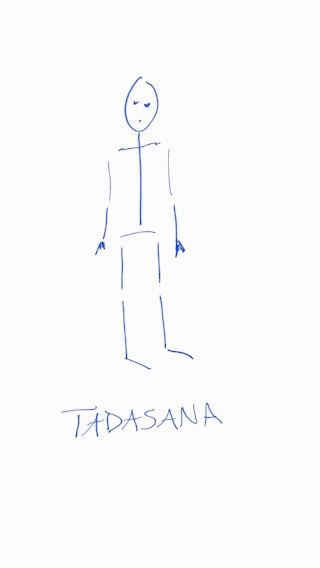Moon weather: Waning Gibbous (first 7 days after full moon)
gathering, harvesting, sharing with others (careful of overspending)
INTRO: On Pain
Over years the wear and tear on the body—normal aging along with biases through injury—makes us less eager to fully engage with and feel the body. In reality the mind and body cannot be separated, so cutting off the intelligence of the body renders us informationally starved.
Yoga helps us reconnect and thereby form a more sensitive relationship with ourselves and our surroundings.
We activate our feeling in the body with yoga—this is the process and this is what yoga does, essentially bringing us back into a loving relationship with ourselves (if love can be counted on as attention, interest, nurturance and protection).
The challenge is in getting into the practice and past the pain involved at first when we start exercising again.
Not to mention embarrassment and fear of not being limber or flexible enough.
Saying you’re not flexible enough for yoga is like saying you’re too dirty to take a bath. (Yogi maxim)
Words I have heard from my students:
“Clumsy” “self-conscious” “awkward” “not coordinated” “not athletic”
“The first things you notice are painful.”
And I remember now how awkward and self-conscious I was when I first started doing yoga, though it was many years ago. I noticed it by its absence a few years ago, when I was doing yoga in a park.
I don’t think it’s because I was better at it, per se, but I was more comfortable and could tune in despite the activities going on around me. I’m more “advanced,” cuz I care more about how I feel than how I look, maybe. Less distracted by irrelevancies.
Yoga the practice develops competencies that show up in the rest of life in funny ways. The pattern is the same: yoga seemed to teach ease and flexibility, understanding, confidence, and compassion, first in yoga (for the self) and then beyond.
The pain involved in starting a new practice teaches us about pushing our mental edges while respecting physical edges. We’ll talk about the edge more next time.
The Daily Practice: Strength and length
With yoga, standing poses build strength and length, and integration of the skeleton and muscles. This enhances alignment and eventually produces fluidity and light strength.
Try this a few times, aiming for a few minutes a day.
Centering (5 minutes)
Sit or lay down comfortably. Close the eyes. Use a recorded audio of your own voice, or any short breath-focused meditation.
Keys:
Keep the breath soft.
Pay attention to the breath, but not too intensely.
Other thoughts will start to form.
Maintain calm.
Pay attention to the breath in the belly. It will expand on the inhalations, and contract on exhalations.
Soften the jaw and tongue. Let the eyes become still and soft, whether open or closed.
Mountain/Tadasana

Stand on two feet, knees unlocked.
Feel the feet connect with the floor, rooting down evenly.
Breathe, sensing the whole body from the ground up.
Bring both arms out to the side and rotate open from the shoulder joint.

Upward Hand Pose / Urdva Hastasana
As you inhale, lift your arms up at the sides. Keep the arms lifted but let the shoulder joint become heavy. The arms can be in a vee, but keep them straight. Let the muscles of the upper arms draw toward the ears.
Release arms down to the sides on exhalation, rotating them internally as you lower.
Take a few neutral breaths.
Utkatasana / Powerful fierce pose

Stand in tadasana with feet parallel, either together or at hip width distance, knees unlocked, shoulders up and back, arms hanging loosely at your sides.
As you inhale, externally rotate the arms from the shoulders and lift the arms overhead.
As you exhale, bend the knees as if you were about to sit in a chair. Keep the chest lifting.
Keep the knees behind your toes.
Lift the sitting bones to sit deeper back into the heels.
Ground your shoulders into the back as you hold the arms aloft.
Engage the legs as you inhale to stand; exhaling, rotate the arms out and float them slowly down to your sides.
Breathe and feel the effects of the pose, particularly noticing if you have any sensations in your lower back.
Forward Fold (Uttanasana)


In Tadasana, lift the sitting bones to stand slightly more on the backs of the legs. Slightly bend the knees.
Hands move to pelvic rim, elbows face back.
Inhale as you lift the chest in a modest backbend. As you exhale lift the sitting bones to fold half-way forward.
Keep the chest lifting, don’t round the back. Hold and breath. Breathe into the mid-back.
After a few breaths let the back round (keep knees a bit bent).
Relax and soften for a couple of breaths, letting the head be heavy.
To come up, bend the knees and as you inhale lift the chest halfway. On the next in-breath lift all the way back to standing.
Rest in Tadasana for several neutral breaths. Release the previous pose completely.
Savasana / Corpse Pose
Take a few moments to relax again, if possible lay down for a few minutes. Let the body integrate the movements, and release any gripping. Sink into the floor beneath you.
Henri below demonstrates legs up the wall pose, a Savasana option.

Have a great week!
If any of this isn’t computing, I do in-person and tele-sessions. A few sessions can get you on the right track, and you can touch base as needed afterwards.
Emily at Bija Yoga
Copyright © 2018 Bija Works All rights reserved.